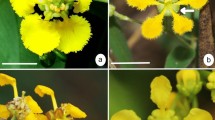Abstract
I have investigated the reproductive biology of four dioecious species of Lindera in Japan: Lindera obtusiloba Bl., L. umbellata Thunb., L. erythrocarpa Makino, and L. glauca Bl. The sex ratios in populations of the first three species are close to equality, but in L. glauca only female individuals are found in Japan, although males are known from continental Asia. The persistence of this dioecious species in the absence of males is surprising, and prompts the question: What mechanisms operate to ameliorate problems of colonization in species of Lindera? I carried out bagging experiments in order to test for apomixis (asexual reproduction by seeds) and to establish the importance of pollination and fertilization, and potential pollen vectors. Only L. glauca reproduced by apomixis. Level of fruit set was high, and was not affected by pollination. In the other three species, seed set was entirely dependent on pollen transfer, which could be accomplished by small Coleoptera and Diptera. The evolution of apomixis in L. glauca appears to have been a strategy to overcome sterility and establish a population in the Japanese islands even in the absence of males. However, this change in breeding system has not occurred in congeneric, co-occurring species, which do not seem to have experienced a lack of male plants.
Similar content being viewed by others
Author information
Authors and Affiliations
Additional information
Received: May 9, 2002 / Accepted: October 25, 2002
Acknowledgments This study was carried out during a stay at Kyoto University in 1997–1998. I am grateful to M. Kato for access to laboratory facilities, and for valuable advice and discussions. A. Naiki is thanked for help in the field and for fruitful discussions. D. M. Hansen, E. D. Parker, M. Kato, J. M. Olesen, and two anonymous reviewers are acknowledged for useful comments on an earlier draft of the manuscript. This study was supported financially by a grant from the Faculty of Sciences, University of Aarhus, Denmark, and by Mr. and Mrs. Fiedler's grant.
Rights and permissions
About this article
Cite this article
Dupont, Y. Evolution of apomixis as a strategy of colonization in the dioecious species Lindera glauca (Lauraceae). Popul Ecol 44, 0293–0297 (2002). https://doi.org/10.1007/s101440200033
Issue Date:
DOI: https://doi.org/10.1007/s101440200033




